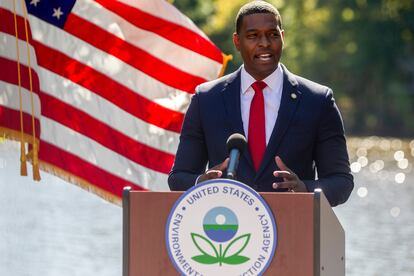US will limit toxic ‘forever chemicals’ in drinking water
Environmentalists are praising the Environmental Protection Agency’s proposal as a long-awaited public health measure

The Environmental Protection Agency on Tuesday proposed limiting the amount of harmful “forever chemicals” in drinking water to the lowest level that tests can detect, a long-awaited protection the agency said will save thousands of lives and prevent serious illnesses, including cancer.
The plan marks the first time the EPA has proposed regulating a toxic group of compounds that are widespread, dangerous and expensive to remove from water. PFAS, or per- and polyfluorinated substances, don’t degrade in the environment and are linked to a broad range of health issues, including low birthweight babies and kidney cancer. The agency says drinking water is a significant source of PFAS exposure for people.
“The science is clear that long-term exposure to PFAS is linked to significant health risks,” Radhika Fox, assistant EPA administrator for water, said in an interview.
Fox called the federal proposal a “transformational change” for improving the safety of drinking water in the United States. The agency estimates the rule could reduce PFAS exposure for nearly 100 million Americans, decreasing rates of cancer, heart attacks and birth complications.
The chemicals had been used since the 1940s in consumer products and industry, including in nonstick pans, food packaging and firefighting foam. Their use is now mostly phased out in the US, but some still remain.
The proposal would set strict limits of 4 parts per trillion, the lowest level that can be reliably measured, for two common types of PFAS compounds called PFOA and PFOS. In addition, the EPA wants to regulate the combined amount of four other types of PFAS. Water providers will have to monitor for PFAS.
The public will have a chance to comment, and the agency can make changes before issuing a final rule, which is expected by the end of the year. Water providers will have time to adjust.
Environmental and public health advocates have called for federal regulation of PFAS chemicals for years. Over the last decade, the EPA has repeatedly strengthened its protective, voluntary health thresholds for the chemicals but has not imposed mandatory limits on water providers.
Public concern has increased in recent years as testing reveals PFAS chemicals in a growing list of communities that are often near manufacturing plants or Air Force bases.
Until now, only a handful of states have issued PFAS regulations, and none has set limits as strict as what the EPA is proposing. By regulating PFOA and PFOS at the minimum amounts that tests can detect, the EPA is proposing the tightest possible standards that are technically feasible, experts said.
“This is a really historic moment,” said Melanie Benesh, vice president of government affairs at the Environmental Working Group. “There are many communities that have had PFAS in their water for decades who have been waiting for a long time for this announcement to come out.”
The agency said its proposal will protect everyone, including vulnerable communities, and reduce illness on a massive scale. The EPA wants water providers to do testing, notify the public when PFAS are found and remove the compounds when levels are too high.
Utilities that have high levels of a contaminant are typically given time to fix problems, but they could face fines or loss of federal grants if problems persist.
The proposal would also regulate other types of PFAS like GenX Chemicals, which manufacturers used as a substitute when PFOA and PFOS were phased out of consumer products. The proposal would regulate the cumulative health threat of those compounds and mandate treatment if that threat is too high.
The EPA recently made $2 billion available to states to get rid of contaminants such as PFAS and will release billions more in coming years. The agency also is providing technical support to smaller communities that will soon be forced to install treatments systems, and there’s funding in the 2021 infrastructure law for water system upgrades.
But still, it will be expensive for utilities to install new equipment, and the burden will be especially tough for small towns with fewer resources.
“This is a problem that has been handed over to utilities through no fault of their own,” said Sri Vedachalam, director of water equity and climate resilience at Environmental Consulting & Technology Inc.
Many communities will need to balance the new PFAS requirements with removing poisonous lead pipes and replacing aged water mains prone to rupturing, Vedachalam said.
Fox said there “isn’t a one-size answer” to how communities will prioritize their needs. She said, however, that there are billions of dollars in federal resources available for water improvements.
Several states have already imposed PFAS drinking water limits. Officials in Michigan, which has the tightest standards of any state, said costs to remove PFAS in communities where it was found were reasonable.
If the rules are finalized and imposed, many communities will learn they have been supplying drinking water with harmful compounds. When people learn of problems, they may stop using tap water altogether, distrusting its safety, and turn instead to bottled water. That’s often a more expensive choice and one that can have negative health effects if people replace tap water with sugary drinks that cause cavities and contribute to obesity and other health problems.
“This,” Fox said, “is such an issue of concern for people.”
Sign up for our weekly newsletter to get more English-language news coverage from EL PAÍS USA Edition
Tu suscripción se está usando en otro dispositivo
¿Quieres añadir otro usuario a tu suscripción?
Si continúas leyendo en este dispositivo, no se podrá leer en el otro.
FlechaTu suscripción se está usando en otro dispositivo y solo puedes acceder a EL PAÍS desde un dispositivo a la vez.
Si quieres compartir tu cuenta, cambia tu suscripción a la modalidad Premium, así podrás añadir otro usuario. Cada uno accederá con su propia cuenta de email, lo que os permitirá personalizar vuestra experiencia en EL PAÍS.
¿Tienes una suscripción de empresa? Accede aquí para contratar más cuentas.
En el caso de no saber quién está usando tu cuenta, te recomendamos cambiar tu contraseña aquí.
Si decides continuar compartiendo tu cuenta, este mensaje se mostrará en tu dispositivo y en el de la otra persona que está usando tu cuenta de forma indefinida, afectando a tu experiencia de lectura. Puedes consultar aquí los términos y condiciones de la suscripción digital.
More information
Archived In
Últimas noticias
The complicated life of Francesca Albanese: A rising figure in Italy but barred from every bank by Trump’s sanctions
Half of Scotland is in the hands of 420 property owners
Pinochet’s victims grapple with José Antonio Kast’s rise in Chile
Reinhard Genzel, Nobel laureate in physics: ‘One-minute videos will never give you the truth’
Most viewed
- Pablo Escobar’s hippos: A serious environmental problem, 40 years on
- Why we lost the habit of sleeping in two segments and how that changed our sense of time
- Charles Dubouloz, mountaineering star, retires at 36 with a farewell tour inspired by Walter Bonatti
- Reinhard Genzel, Nobel laureate in physics: ‘One-minute videos will never give you the truth’
- The Florida Keys tourist paradise is besieged by immigration agents: ‘We’ve never seen anything like this’










































